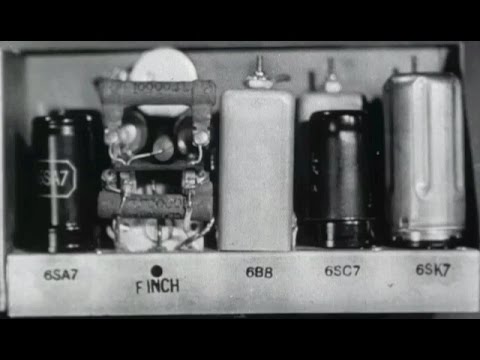Spy Radio in World War II: “Strategic Service Transmitter-Receiver Number 1” SSTR-1 OSS
more at
Circa 1943. “Office of Strategic Services. Field Photographic Branch… Instructional Film: Describes the radio transmitter-receiver unit used during World War II. Explains compactness and ease of concealment, and outlines operations in detail: selection of electrical outlet, battery, or combination of both as power unit; antenna, assembly parts, installation, frequency determination and receiver operation; parts installation, attachment of crystal equipment and transmitter operation.”
Reupload of a previously uploaded film, in one piece instead of multiple parts.
Public domain film from the National Archives, slightly cropped to remove uneven edges, with the aspect ratio corrected, and mild video noise reduction applied.
The soundtrack was also processed with volume normalization, noise reduction, clipping reduction, and equalization (the resulting sound, though not perfect, is far less noisy than the original).
…The SSTR-1 “Suitcase Radio”
Probably the most famous clandestine radio used by OSS personnel was the SSTR-1 set. It was a portable HF receiver, transmitter, and power supply combination that was typically carried in a “suitcase”. RDR was involved in the development (see the “RDR Corp.” section), as was Pioneer Electric and Research in Forest Park, Illinois. A manufacturer of the SSR-1 receiver is reported to have been Finch Telecommunications of Passaic, NJ [ref. 28, page 233].
Major Henry Shore, a former RCA employee, was in charge of the development of the SSTR-1. Shore wanted RCA labs in NYC to work on the project, but they were much too busy with other wartime projects, so it was agreed that an RCA employee, Earl Anderson, would work at home on his own time. Anderson was given one of the existing AC/DC sets as a starting point, but he had to make major design changes, especially in the transmitter. According to Dean Cortright, the dimensions of the units were chosen so that they could fit inside a typical European loaf of bread. During the war, updates were made to the design, which resulted in changes in the specifications. Receivers went up to at least version “G”, and transmitters to version “E”. National Archives photos show at least 5 variations of the SST-1, each of which is different from the SST-1-E pictured below [see Brunner, ref. 28, pages 234-235]. One variant includes an RF ammeter to indicate antenna current, while 3 other variants appear to have a round filler panel to replace the meter with an antenna tuner knob that is marked ‘RF Amperes’ in conjunction with a resonance indicator lamp. The Archives photos also show two variants of the SSR-1 that are each different from the SSR-1-G pictured below. One of the SSR-1 models appears to be a very early version, as it covers 2.7-16 MC (not 17 MC), and uses a 0-100 tuning dial that is not calibrated for frequency…
SSTR-1 notes from a user:
It had a single 6L6 as a tri-tet oscillator/final and had 10 watts power output. However opening the long slender case the 6L6 was mounted horizontally and could be immersed in a jar of motor oil. Then with a better power supply I could turn this into 50 or more watts. Also with more filtering it would follow a bug at 25 wpm, which it would not do so before. There was also an ancillary unit which was a power amplifier using a single 815 tube and a pi-coupler antenna tuner in the same enclosure.
The thermocouple device [battery charger] was [nicknamed] the YTB-1 (“Yak Turd Burner”). The official nomenclature of the YTB-1 was the SSP-3.
The SSR-1 receiver was noted for drifting. We used to remove the screws from the case and remove the guts from the case just a bit, and using a pencil to move the case slightly back and forth it was nudged back to frequency…

